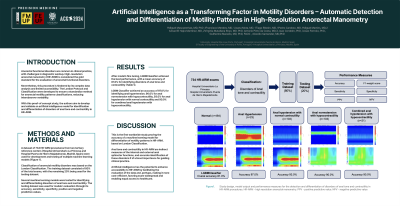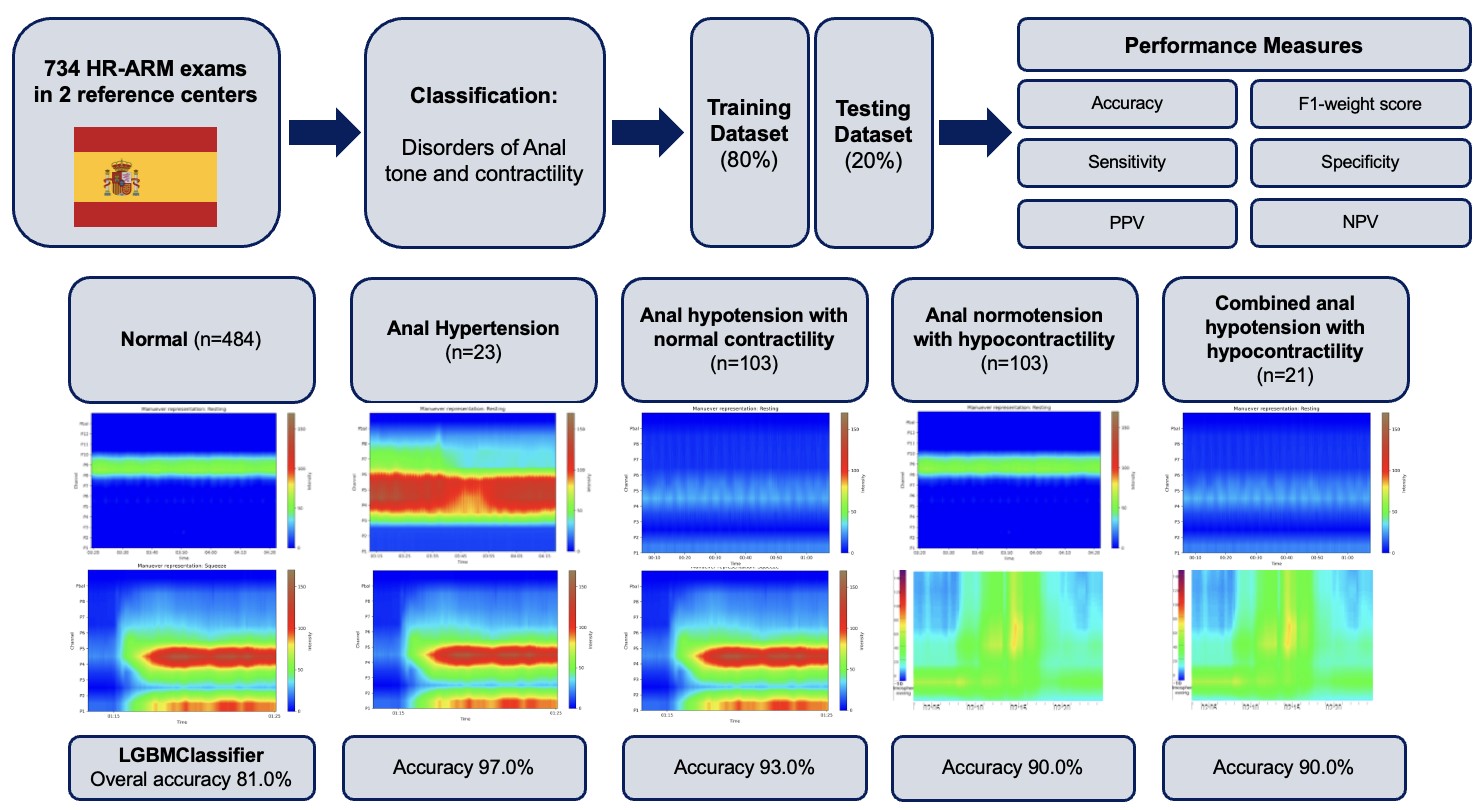Tuesday Poster Session
Category: Functional Bowel Disease
P4054 - Artificial Intelligence as a Transforming Factor in Motility Disorders - Automatic Detection and Differentiation of Motility Patterns in High-Resolution Anorectal Manometry
Tuesday, October 29, 2024
10:30 AM - 4:00 PM ET
Location: Exhibit Hall E

Has Audio

Miguel Mascarenhas, MD, PhD
Centro Hospitalar Universitário de São João
Porto, Porto, Portugal
Presenting Author(s)
Miguel Mascarenhas, MD, PhD1, Francisco Mendes, MD1, Joana Mota, MD1, Tiago Ribeiro, MD1, Pedro Cardoso, MD1, Miguel Martins, MD1, Ismael El Hajra Martinez, MD2, Virginia Matallana Royo, MD, PhD2, Antonio Pinto da Costa, MD2, Joao Cordeiro, PhD3, Joao Ferreira, PhD.4, Guilherme Macedo, MD, PhD, FACG1, Cecilio Santander, MD, PhD5
1Centro Hospitalar Universitário de São João, Porto, Porto, Portugal; 2Hospital Universitario Puerta de Hierro-Majadahonda, Madrid, Madrid, Spain; 3University Institute of Lisbon, Lisbon, Lisboa, Portugal; 4University of Porto, Porto, Porto, Portugal; 5Hospital Universitario de La Princesa, Madrid, Madrid, Spain
Introduction: Anorectal functional disorders are common in clinical practice, with challenges in diagnostic workup. High-resolution anorectal manometry (HR-ARM) is considered the gold standard for the evaluation of anorectal functional disorders. Nevertheless, this procedure is hindered by its complex data analysis and limited accessibility. The London Protocol and Classification were developed to ensure a standardize method for anorectal motility patterns classifications, reducing interobserver variability. With this proof-of concept study, the authors aim to develop and validate an artificial intelligence model for identification and differentiation of disorders of anal tone and contractility in HR-ARM.
Methods: A dataset of 734 HR-ARM procedures from 2 high volume reference centers were used for development and testing of multiple machine learning models (Figure 1). Classification of anorectal motility disorders was based on the London Classification. The training dataset consisted of 80% of the total exams, with the remaining 20% being used for the testing dataset. Several machine learning models were tested for identifying and differentiating disorders of anal tone and contractility. The testing dataset was used for models’ evaluation through its accuracy, sensitivity, specificity, positive and negative predictive values.
Results: After model’s fine tuning, LGBMClassifier achieved the best performance, with a mean accuracy of 81.0% for identifying disorders of anal tone and contractility (Table 1). LGBM Classifier achieved an accuracy of 97.0% for identifying anal hypertension, 90.0% for anal normotension with hypocontractility, 93.0% for anal hypotension with normal contractility and 90.0% for combined anal hypotension with hypocontractility.
Discussion: This is the first worldwide study proving the accuracy of a machine learning model for differentiation of motility patterns in HR-ARM, based on London Classification. Anal tone and contractility in HR-ARM are indirect measures of the internal and external anal sphincter functions, and accurate identification of these disorders if of utmost importance for guiding clinical practice. Artificial intelligence has the potential to enhance accessibility to HR-ARM by facilitating the evaluation of the data and, perhaps, making it more cost-efficient, favoring exam widespread and enabling equal access to healthcare.

Disclosures:
Miguel Mascarenhas, MD, PhD1, Francisco Mendes, MD1, Joana Mota, MD1, Tiago Ribeiro, MD1, Pedro Cardoso, MD1, Miguel Martins, MD1, Ismael El Hajra Martinez, MD2, Virginia Matallana Royo, MD, PhD2, Antonio Pinto da Costa, MD2, Joao Cordeiro, PhD3, Joao Ferreira, PhD.4, Guilherme Macedo, MD, PhD, FACG1, Cecilio Santander, MD, PhD5. P4054 - Artificial Intelligence as a Transforming Factor in Motility Disorders - Automatic Detection and Differentiation of Motility Patterns in High-Resolution Anorectal Manometry, ACG 2024 Annual Scientific Meeting Abstracts. Philadelphia, PA: American College of Gastroenterology.
1Centro Hospitalar Universitário de São João, Porto, Porto, Portugal; 2Hospital Universitario Puerta de Hierro-Majadahonda, Madrid, Madrid, Spain; 3University Institute of Lisbon, Lisbon, Lisboa, Portugal; 4University of Porto, Porto, Porto, Portugal; 5Hospital Universitario de La Princesa, Madrid, Madrid, Spain
Introduction: Anorectal functional disorders are common in clinical practice, with challenges in diagnostic workup. High-resolution anorectal manometry (HR-ARM) is considered the gold standard for the evaluation of anorectal functional disorders. Nevertheless, this procedure is hindered by its complex data analysis and limited accessibility. The London Protocol and Classification were developed to ensure a standardize method for anorectal motility patterns classifications, reducing interobserver variability. With this proof-of concept study, the authors aim to develop and validate an artificial intelligence model for identification and differentiation of disorders of anal tone and contractility in HR-ARM.
Methods: A dataset of 734 HR-ARM procedures from 2 high volume reference centers were used for development and testing of multiple machine learning models (Figure 1). Classification of anorectal motility disorders was based on the London Classification. The training dataset consisted of 80% of the total exams, with the remaining 20% being used for the testing dataset. Several machine learning models were tested for identifying and differentiating disorders of anal tone and contractility. The testing dataset was used for models’ evaluation through its accuracy, sensitivity, specificity, positive and negative predictive values.
Results: After model’s fine tuning, LGBMClassifier achieved the best performance, with a mean accuracy of 81.0% for identifying disorders of anal tone and contractility (Table 1). LGBM Classifier achieved an accuracy of 97.0% for identifying anal hypertension, 90.0% for anal normotension with hypocontractility, 93.0% for anal hypotension with normal contractility and 90.0% for combined anal hypotension with hypocontractility.
Discussion: This is the first worldwide study proving the accuracy of a machine learning model for differentiation of motility patterns in HR-ARM, based on London Classification. Anal tone and contractility in HR-ARM are indirect measures of the internal and external anal sphincter functions, and accurate identification of these disorders if of utmost importance for guiding clinical practice. Artificial intelligence has the potential to enhance accessibility to HR-ARM by facilitating the evaluation of the data and, perhaps, making it more cost-efficient, favoring exam widespread and enabling equal access to healthcare.

Figure: Figure 1 - Study design, model output and performance measures for the detection and differentiation of disorders of anal tone and contractility in HR-ARM procedures. HR-ARM - high resolution anorectal manometry. PPV - positive predictive value. NPV - negative predictive value
Disclosures:
Miguel Mascarenhas indicated no relevant financial relationships.
Francisco Mendes indicated no relevant financial relationships.
Joana Mota indicated no relevant financial relationships.
Tiago Ribeiro indicated no relevant financial relationships.
Pedro Cardoso indicated no relevant financial relationships.
Miguel Martins indicated no relevant financial relationships.
Ismael El Hajra Martinez indicated no relevant financial relationships.
Virginia Matallana Royo indicated no relevant financial relationships.
Antonio Pinto da Costa indicated no relevant financial relationships.
Joao Cordeiro indicated no relevant financial relationships.
Joao Ferreira indicated no relevant financial relationships.
Guilherme Macedo indicated no relevant financial relationships.
Cecilio Santander indicated no relevant financial relationships.
Miguel Mascarenhas, MD, PhD1, Francisco Mendes, MD1, Joana Mota, MD1, Tiago Ribeiro, MD1, Pedro Cardoso, MD1, Miguel Martins, MD1, Ismael El Hajra Martinez, MD2, Virginia Matallana Royo, MD, PhD2, Antonio Pinto da Costa, MD2, Joao Cordeiro, PhD3, Joao Ferreira, PhD.4, Guilherme Macedo, MD, PhD, FACG1, Cecilio Santander, MD, PhD5. P4054 - Artificial Intelligence as a Transforming Factor in Motility Disorders - Automatic Detection and Differentiation of Motility Patterns in High-Resolution Anorectal Manometry, ACG 2024 Annual Scientific Meeting Abstracts. Philadelphia, PA: American College of Gastroenterology.
